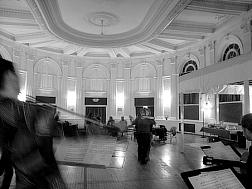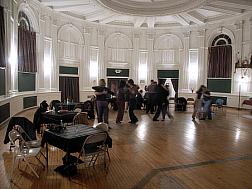 Email This Page
Email This PageTango at Jack O' Lantern
On a Wednesday night
 Email This Page
Email This PageNew location for wednesdays (21 January 2004 by Mike Strong, photos by Mike Strong)
 Kansas
City tangoers have a new home for the Wednesday evening lesson and milonga.
Kansas
City tangoers have a new home for the Wednesday evening lesson and milonga.
Morton Hall, Jack O' Lantern Ballroom, the Old Westport Ballet building, whatever you call her, is a classy old joint. She is nearly a hundred years old. She is a bit in need of repairs. A few holes where rain makes its way in during wet times. Boards over the lower part of her surrounding windows. A few plaster formations on the walls broken. Runs in her stockings, so to speak.
Regardless, she excudes a warm greeting, in her oval shape, as though this old building were throwing a protective arm around whomever ventures inside. The rounded room is probably a good 80x40 feet, maybe more. Classic square columns reach upward along the walls to join overhead beams which in turn join in the center of the ceiling like a maternal embrace.
From January through March, at least, the tanqueros in Kansas City have the building as their new Wednesday evening home. Morton Hall is owned by the First Calvary Baptist church next door and behind at 3921 Baltimore. John Morton was an early Baptist luminary of the late 1500s' and early 1600's (footnote below). A small group is working to retrieve the history of this building and perhaps obtain some funding.
 Tonight,
January 21, 2004, on the first regular wednesday in Morton Hall, the family
is a small one. The location is off the beaten track, just off Westport Road.
Actually just west of Main at 40th street, where Westport and Main come together.
Then you have to go around the back and down a half flight of stairs. Maybe
twenty persons convened tonight, this clan of floor shufflers. The core group
in Kansas City is maybe 50 or 60. Like other dance group styles the extended
group is probably five to ten times the number of the core. The core is that
group of dancers who will most always show at the events.
Tonight,
January 21, 2004, on the first regular wednesday in Morton Hall, the family
is a small one. The location is off the beaten track, just off Westport Road.
Actually just west of Main at 40th street, where Westport and Main come together.
Then you have to go around the back and down a half flight of stairs. Maybe
twenty persons convened tonight, this clan of floor shufflers. The core group
in Kansas City is maybe 50 or 60. Like other dance group styles the extended
group is probably five to ten times the number of the core. The core is that
group of dancers who will most always show at the events.
Laura Allen sits at the door, taking in admission. Korey Ireland is in the background teaching the dancers how to tango. He is teaching the tango of the salons of Argentina. The lesson is from 7pm to 8pm. Open dancing, the milonga, is from 8pm until everyone is ready to go home. Admission is $10 on live-music nights and $5 on DJ-music nights. Korey has a full DJ music program on his laptop and it is playing the music for the lesson through an amplifier into speakers on shoulder-high stands. Tonight, for the milonga, we will have live music.
Tango Lorca is playing. These are award winning musicians who play with a variety of groups. They are also the live-music foundation of tango in KC since 1999. Beau Bledsoe has been the core of Tango Lorca since it was Duo Lorca years ago. As the members have changed over these years, Beau is the one who has always been there, playing classical guitar. Tonight the members are Tiffany Thompson, violin; Lidia Kaminska, accordion; Mark Lowery, piano; and Beau Bledsoe, guitar. Bass player Jeff Harshbarger is elsewhere tonight.
I am tempted to borrow from "Battlestar Galactica" and describe a small, rag-tag group fleeing from aliens and looking for a new home somewhere in the stars. However, there are no Cylons to flee from, though I suppose I could name a certain vulgarian and get proudly cheap cheers (shamefully fun) but I've done it elsewhere.
And these dancers are not a rag-tag bunch. All are comfortably well dressed from suits (a few) to office casual (most). And all are "of good cheer" with each other. Chatting over bottled water and snacks. In the wonderful British sense of the word homely, they are home-ly. Warm. They are still family in the city even though they have been nomads for nearly half a year.
The tangoers were booted out of a comfortable home at Fedora's 210 on the Plaza when that place closed to be replaced by yet another sports bar. Nothing has yet really fit them. Moving from place to place the large crowd which convened at Fedora's is not always able to keep up with the locations. Then again they need to get used to paying admissions. At Fedora's, it was free to walk in the doors. You could take the free lessons and sneak past the tip jar. I hate to admit it to anyone not a dancer, so if you don't dance don't listen because you really won't understand, but we dancers can be cheap.
To understand the tango you need to know that the tango is not merely a dance step. Nor a ball. And while it is often billed as drama, often with a dramatic illustration of two dancers sliding across each other in a diagonal pose, tango doesn't ring cymbals and play a fanfare. This is a people's art. Neither choreographed nor staged. Though all the members of this crowd also love performances. Some are even participants and competitors. Just the same, this place and this time is down i the roots, where all art truly lives and belongs, with the people.
Tango is a close and quite musical performance played out between the two
actors in an "A"-hug embrace, private within the community of dancers
on the floor. Tango is a community of closeness and intimacy. Tango is a home.
Tango is a small village which congregates from a wide area, on an intimate
though not always small dance floor, always a salon with a human-warmed dance
floor filled with small privately-public shape-shifting families. A small
tribe in the clan of Tangoers. A people intent on a people's art.
When Fedora's 210 on the Plaza closed the Fedora's tango family experienced a city-wide mini diaspora. These Fedorans looked for a new home. They phoned and emailed each other. Locations here and locations there. The Phillips Hotel downtown looked like a possible. It had classic looks and the tango group gave it a go but it just wasn't intimate and wasn't that friendly for "family" activities such as home-baked goods.
The Phillips Hotel really wasn't the right atmosphere. It was a ballroom, not an intimate locale for friends. The Phillips hotel also wanteed a two-drink minimum and dancers are really not drinkers. Here, if anyone wants a drink it is water, soda, juice or byob. At the hotel the Kansas City tanquero tribe couldn't bring in snacks.
Here, at Morton/Jack/Ballet, and at the Sunday Milonga at Westport Presbyterian, the tangoers bake cookies and cakes to share along with other pot-luck snacks. And they stand or sit in relaxed poses to talk with each other. Each milonga is a family gathering.

Links:
- Korey Ireland's Tango site: http://www.kodair.com/tango
- Tango Lorca, the starting page for their website: http://www.tangolorca.com
- Tango Lorca Bios, current and past musicians in the group: http://www.tangolorca.com/biostango.html
Note: Small excerpt from a very, very long page by John T. Christian, A.M. D.D. LL.D. at http://www.trailofblood.com/History%20Of%20Baptists.htm "John Morton was one of John Smyth's disciples at Amsterdam from whom he received baptism by immersion. He afterwards came to England, was a zealous preacher of the sentiments of the General Baptists, etc." ... "The affirmation is that Morton, in 1615, was in the practice of dipping. He differed with some on Free Grace, but not on the act of baptism."
 Email This Page
Email This Page